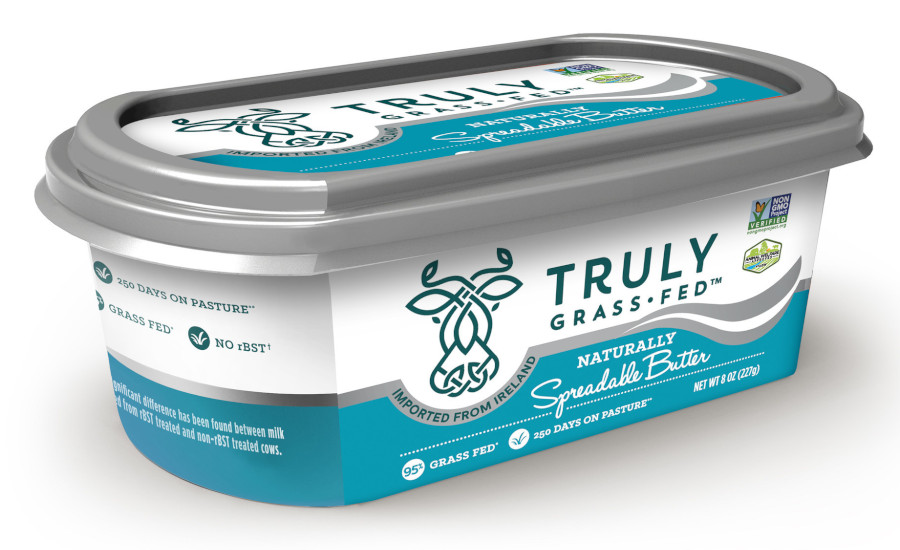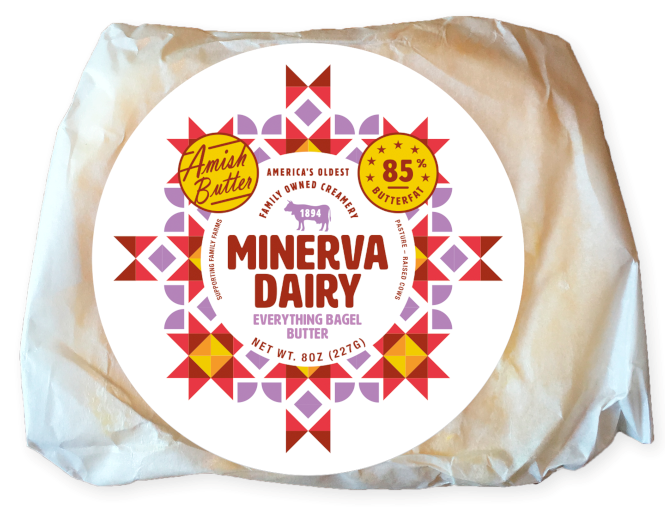Butter and creamers might not land a starring role on the plate or in the bowl like their cheese and ice cream dairy cousins, but they are important and versatile supporting actors. Butter enhances the flavor and appeal of foods ranging from cookies to lobster, while creamers elevate coffee and other beverages and can add richness to culinary dishes.
Moreover, the butter and creamer categories are no longer limited to commodity-type offerings. The categories have been riding an innovation wave in recent years.
Premium, natural rule in butter
During the height of the COVID-19 pandemic, butter sales took off as more consumers cooked at home. Sales have since cooled off for much of the butter set. Premium butter, however, continues to be an overachiever within the category.

“Premium butter continues to show growth as the rest of the butter section settles back from the COVID sales spike,” says Venae Watts, fifth-generation co-owner of Minerva Dairy, Minerva, Ohio. “Consumers are continuing to cook at home and … research products they bring home. This is great news for premium butter manufacturers.”
In response, retailers have been adding shelf space to support the premium butter set, she notes.
Nicola O’Connell, head of commercial for Dublin-based Glanbia brand Truly Grass Fed, also sees strong consumer interest in premium butters — noting that “consumers are trading up to better products.”
On the premium front, Dublin, Calif.-based Challenge Dairy Products Inc. recently introduced spreadable butter with 100% pure avocado oil under its Challenge Butter brand, notes Michael Burdeny, president of the company.
The shift to premium goes hand in hand with the shift to natural.
“Overall, we see strong growth in premium natural categories,” O’Connell says. “Consumers are seeking more nutritious products, reading labels, parsing ingredient lists, and examining certifications. It may be that … consumers are looking for ways to improve their health after two-plus years living with a pandemic.”
Burdeny agrees, noting that consumers also are seeking out products with fewer ingredients.
Speaking of fewer ingredients, Truly Grass Fed launched a spreadable butter this year that boasts only two: sweet cream sourced from grass-fed cows and salt. Its natural spreadability comes from softer fats resulting from the Truly Grass Fed pasture-based grazing system and the cows' summertime milk production.
“It’s integral for butter-makers to be transparent about their farming practices and where the milk that creates their products comes from.” — Michael Burdeny, president, Challenge Dairy Products Inc.
Consumers are also more concerned than ever about the origin of their foods and gravitate toward products “from companies that value transparency and sustainability,” Burdeny says.
“It’s integral for butter-makers to be transparent about their farming practices and where the milk that creates their products comes from,” he notes. “For example, Challenge is committed to becoming a leader in sustainable farming and animal welfare practices.”
O’Connell adds that the demand for “purpose-driven, environmentally conscious brands” has been on the rise.
“Sustainably produced brands like Truly Grass Fed are helping to drive category growth,” she says. “Consumer awareness of climate change and increasing focus on overall health and wellness are influencing buying habits. Consumers are looking for butter products labeled grass-fed, animal welfare approved, and non-GMO.”
Flavored butter boasts appeal, too
Added flavors are on trend, too, within the butter space — particularly on the premium side.
“I see two splits emerging: trending flavors and complexity of taste to staple products,” Watts points out.
Minerva Dairy recently tapped into the trending flavors side with the introduction of a limited-edition premium butter with everything bagel seasoning, Watts notes. In addition, Minerva Dairy’s premium Garlic Herb butter — a permanent offering — adds complexity to dishes and has been gaining retail shelf space, Watts notes. She predicts that the next trending flavor in the butter space will be black lime.
As for the other split, that’s tied to consumers’ desire for ingredients to kick their home cooking “up a notch” and “add layers of complexity without overpowering the dish,” she says. Crafted butters have the depth of flavors to allow them to do this.

This spring, Challenge Butter also tapped into the flavored butter trend — as well as the ongoing trend toward snacking — with its butter Snack Spreads (see the Eat.Drink.Dairy. section in this issue). Billed as easy to use for topping, dipping, spreading, slathering, sauteing, and more, the lineup comes in three dessert Snack Spread flavors (Vanilla Fudge, Chocolate Dessert, and Salted Caramel) and three seasoned Snack Spread flavors (Buffalo, Garlic Parmesan & Herb, and Everything Seasoned).
“Challenge Butter designed these Snack Spreads to bring new enthusiasm to the category while also inspiring consumers to use butter during new occasions and dayparts,” Burdeny says. “The Snack Spreads can be used right out the fridge to add fast flavor to meals and snacks using the power of fresh butter and fresh ingredients.”
Creamers are flavored-up, too
Speaking of flavors, they have been trending on the creamer side for a number of years. And that trend shows no signs of slowing down. Much of the recent flavor innovation, however, has been on the nondairy creamer side.
In its October 2021 “United States Coffee Creamer Market” report, Indian market research firm Mordor Intelligence notes that demand for dairy-free creamers is increasing, especially among younger consumers.
“Thus, an increasing number of players have a wide portfolio of dairy-free creamers with innovative flavor,” the report states.



Venae Watts is co-owner of Minerva Dairy, the oldest family-operated creamery in the nation. Minerva Dairy produces premium (85% butterfat) hand-rolled butter. Watts discusses some of the factors behind the strong recent growth in the butter category.
Some of those innovative flavors are limited-time offerings. For example, International Delight — a brand of Broomfield, Colo.- and White Plains, N.Y.-based Danone North America — launched Wonka Whipple Scrumptious Fudgy Caramel creamers this past winter in partnership with Warner Bros. Consumer Products. Offered in 32-ounce bottles, the creamers come in “regular” and sugar-free varieties.
"At International Delight, we exist to transform the room we leave in our coffee cups into moments of celebration, self-expression and joy," says Olivia Sanchez, vice president of marketing for International Delight. "We're on a relentless mission to create delicious creamers that offer unparalleled delight in every drop, brought to life through bold flavors and iconic partnerships."
And Nestlé USA, Arlington, Va., recently added two nondairy creamer flavors under its Coffee-mate Natural Bliss brand: Sweet Crème almond “milk” creamer and Brown Sugar oat “milk” creamer. The two offerings retail in 32-ounce containers.
Creamer packaging a sustainability focus
Flavor variety isn’t the only trend within the creamer set. Packaging sustainability also is a focus. In December 2020, for example, Nestlé USA said it was converting 100% of its creamer portfolio, including Coffee-mate and Coffee-mate Natural Bliss creamers, to fully recyclable bottles by 2022.
In addition, New Berlin, N.Y.-based Chobani LLC chose paper-based recyclable packaging for its new half & half products. The products, which made their debut last winter, come in classic plain and lactose-free options and are made simply from farm fresh milk and cream, Chobani notes.
“We’ve seen incredible consumer love for our coffee creamers, and they asked us to bring the same craft and quality to dairy-based half & half while offering a lactose-free option as well,” says Peter McGuinness, Chobani’s president and chief operating officer.
With the Mordor Intelligence report forecasting a compound annual growth rate of 5.6% for the coffee creamer market between 2021 and 2026, there definitely seems to be room for all of the new on-trend creamer offerings — both dairy and nondairy. Meanwhile, work on the part of Dairy Management Inc. (DMI), Rosemont, Ill., is aiming to ensure dairy creamer gets its due as plant-based offerings proliferate.
DMI, which manages the dairy checkoff with state and regional promotion organizations, says Taco Bell restaurants nationwide recently rolled out a dairy-based coffee creamer and a new coffee drink with support from dairy checkoff food scientists. The vanilla creamer replaces a nondairy product and will become a permanent offering at more than 7,500 Taco Bell locations in the United States. The shelf-stable creamer also was used in the checkoff-created Pineapple Whip Freeze and Island Berry Freeze beverages that previously appeared on Taco Bell’s menu.
Taco Bell consumers who order 12-ounce hot or 20-ounce iced coffee drinks have the option of adding the creamer, DMI says. The DMI product research team worked with the checkoff-funded Midwest Dairy Center at the University of Minnesota to create the creamer in 2020.
The creamer also was featured in the Cinnabon Delights coffee, which was available at participating U.S. Taco Bell locations for a limited time this year. DMI dairy scientist Kimber Lew led the creation workstream and says it demonstrates the chain’s desire to grow its breakfast business.
“We’re really excited for this because we are putting a lot of emphasis into getting consumers to think more about starting their mornings at Taco Bell,” Lew said. “Creating a coffee that has dairy and the iconic craveable Cinnabon Delights flavor was a no-brainer.”




